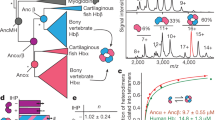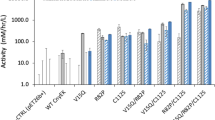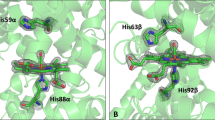Abstract
The expression of β-globin in Escherichia coli has enabled us to study the functional role of individual amino-acid residues in haemoglobin (Hb) by site-directed mutagenesis1. In contrast to mammalian Hbs, some teleost fish haemoglobins show a drastic lowering of oxygen affinity and cooperativity at low pH, a phenomenon known as the Root effect2. We have produced the two mutant haemoglobins Hb Nymphéas [Cys(F9)93β →Ser] and Hb Daphne [His(H21)143β → Arg, Cys(F9)93β → Ser] to investigate this allosteric property. Although these substitutions were thought to be responsible for the Root effect3, Hb Nymphéas and Hb Daphne show an increased oxygen affinity and a reduced effect of pH on oxygen affinity1. Our X-ray Crystallographic studies show that the hydroxyl group of Ser 93β forms a hydrogen bond with Asp 94β which is in equilibrium with the salt bridge between Asp 94β and His 146β. The oxygen-binding properties of Hbs Nymphéas and Daphne are accounted for by the partial disruption of the salt bridge.
This is a preview of subscription content, access via your institution
Access options
Subscribe to this journal
Receive 51 print issues and online access
$199.00 per year
only $3.90 per issue
Buy this article
- Purchase on Springer Link
- Instant access to full article PDF
Prices may be subject to local taxes which are calculated during checkout
Similar content being viewed by others
References
Nagai, K., Perutz, M. F. & Poyart, C. Proc. natn. Acad. Sci. U.S.A. 82, 7252–7255 (1985).
Root, R. W. Biol. Bull. 61, 427–463 (1931).
Perutz, M. F. & Brunori, M. Nature 299, 421–426 (1982).
Kilmartin, J. V. & Rossi-Bernardi, L. Physiol. Rev. 53, 836–890 (1973).
Bohr, C., Hasselbalch, K. & Krogh, A. Skand. Arch. Physiol. 16, 402–412 (1904).
Perutz, M. F. Nature 228, 726–739 (1970).
Imai, K. Allosteric Effects in Haemoglobins (Cambridge University Press, 1982).
Tan, A. L., Nobel, R. W. & Gibson, Q. H. J. biol. Chem. 248, 2880–2888 (1973).
Brunori, M. Curr. Topics cell. Regulation 9, 1–39 (1975).
Perutz, M. F. J. Crystal Growth 2, 54–56 (1968).
Fermi, G., Perutz, M. F., Shannon, B. & Fourme, R. J. molec. Biol. 175, 159–174 (1984).
Perutz, M. F. Molec. Biol. Evol. 1, 1–28 (1983).
Bauer, C. & Jelkmann, W. Nature 269, 825–827 (1977).
Kimura, M. Scient. Am. 241 (5), 94–104 (1979).
Author information
Authors and Affiliations
Rights and permissions
About this article
Cite this article
Luisi, B., Nagai, K. Crystallographic analysis of mutant human haemoglobins made in Escherichia coli. Nature 320, 555–556 (1986). https://doi.org/10.1038/320555a0
Received:
Accepted:
Issue Date:
DOI: https://doi.org/10.1038/320555a0
This article is cited by
-
Structural basis for the Root effect in haemoglobin
Nature Structural Biology (1996)
-
Purification and characterization of recombinantStreptomyces clavuligerus isopenicillin N synthase produced inEscherichia coli
Journal of Industrial Microbiology (1996)
-
Distal residues in the oxygen binding site of haemoglobin studied by protein engineering
Nature (1987)
Comments
By submitting a comment you agree to abide by our Terms and Community Guidelines. If you find something abusive or that does not comply with our terms or guidelines please flag it as inappropriate.



